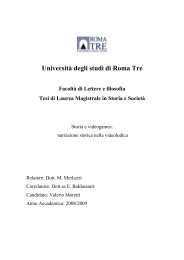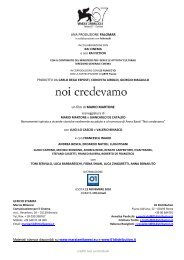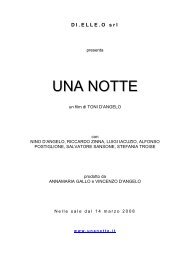Catalogo 1999 - Cineteca di Bologna
Catalogo 1999 - Cineteca di Bologna
Catalogo 1999 - Cineteca di Bologna
You also want an ePaper? Increase the reach of your titles
YUMPU automatically turns print PDFs into web optimized ePapers that Google loves.
Il fenomeno degli artisti e soprattutto degli attori in quanto star non è né un’invenzione del cinema né<br />
qualcosa <strong>di</strong> estraneo all’epoca dei cortometraggi, basti pensare alla popolarità cinematografica <strong>di</strong> un<br />
Otto Reutter o <strong>di</strong> un Max Linder. Ma quando nell’interesse della <strong>di</strong>stribuzione monopolistica prese<br />
piede il lungometraggio, il rapporto della cinematografia con le star mutò. Per la prima volta nella<br />
storia del cinema tedesco (e perfino europeo), in Germania nel 1911 venne “costruita” dalla<br />
<strong>di</strong>stribuzione monopolistica una star, vale a <strong>di</strong>re una carriera con il sostegno della pubblicità, per la<br />
quale l’intensa reclamizzazione dei film <strong>di</strong>stribuiti dalle gran<strong>di</strong> case associate in monopolio offriva una<br />
base eccellente. Cambiò così il carattere della star cinematografica, perché per la prima volta<br />
nell’ambito della strategia <strong>di</strong> commercializzazione si puntò deliberatamente sul nome <strong>di</strong> un attore o <strong>di</strong><br />
una attrice; fino ad allora neppure la Pathé aveva tratto profitto in questo senso dalla popolarità delle<br />
sue star Max Linder o Charles Prince.<br />
Poiché, tanto la pubblicità incentrata sui <strong>di</strong>vi, quanto la stessa idea che nei film tutto l’interesse si<br />
focalizzasse non sull’azione ma sugli interpreti, era ancora estranea al cinema tedesco, la protagonista<br />
della prima iniziativa <strong>di</strong> popolarizzazione <strong>di</strong>vistica si trovò confrontata, rispetto a quasi tutte le attrici<br />
che vennero dopo <strong>di</strong> lei, con un compito enorme, per quanto ella potesse contare su presupposti<br />
particolarmente favorevoli al successo dell’operazione, in quanto non aveva concorrenti. E Asta<br />
Nielsen <strong>di</strong>venne in fin dei conti il mito più potente dei primor<strong>di</strong> della storia del cinema tedesco.<br />
(Corinna Müller, Frühe deutsche Kinematographie. Formale, wirtschaftliche und kulturelle<br />
Entwicklungen, 1994)<br />
The phenomenon of the artist and, above all, the actor as star is neither an invention of cinema, nor<br />
was it unknown in the era of the short film - one only has to think of the popularity of Otto Reutter or<br />
Max Linder. But when it came to establishing the full-length feature film, in the interests of “Monopol<br />
Film Distribution”, cinema’s treatment of the star changed. In 1911 a film star was “built up” in<br />
Germany by the “Monopol Film Distribution”, i.e., a career was promoted with the help of publicity<br />
for the first time in the history of German (even European) cinema. The intensive advertising for<br />
Monopol films offered an excellent basis to do this on. Thus the character of the film star changed. For<br />
the very first time, an actor or actress’s name was used to deliberately and strategically promote sales.<br />
In Germany not even Pathé Frères had cashed in on the popularity of their stars Max Linder or<br />
Charles Prince in this way until then.<br />
Because star publicity and the notion that the actors in a film - not the plot - should be the main focus<br />
of attention were foreign to German cinema, the female protagonist in the first attempts to popularise a<br />
star had a greater task to complete than almost all her successors, although as a pioneer she also met<br />
with no competition in the field and therefore conducive precon<strong>di</strong>tions for establishing herself. And<br />
Asta Nielsen became what she actually was, the most powerful myth in the history of early German<br />
cinema. (Corinna Müller, Frühe deutsche Kinematographie. Formale, wirtschaftliche und kulturelle<br />
Entwicklungen, 1994)<br />
ore 10.00<br />
Divine apparizioni / Divine apparitions - Asta Nielsen<br />
DORA BRANDES (Germania, 1916). R.: Magnus Stifter. S.: Louis Levy, Martin Jörgensen. In.: Asta<br />
Nielsen, Ludwig Trautmann.<br />
35mm. L.: 1209m. D.: 68’ a 16 f/s. Didascali e tedesche / German intertitles.<br />
Da: Det Danske Filmmuseum

















